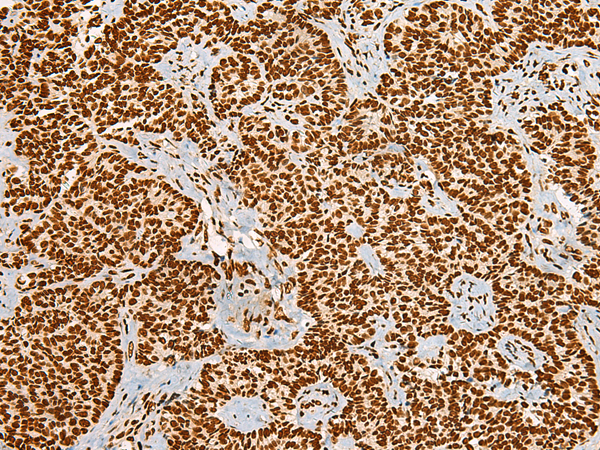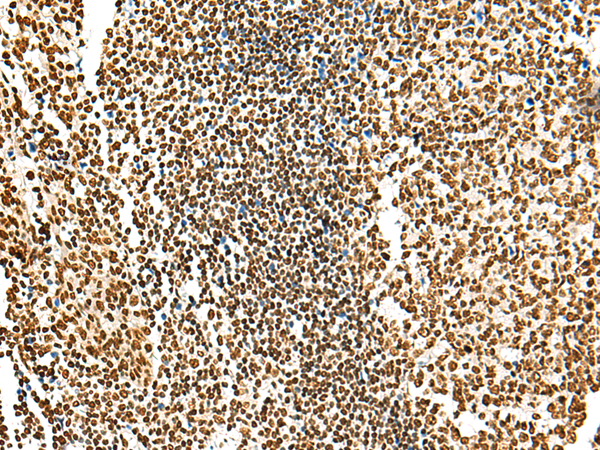

| WB | 咨询技术 | Human,Mouse,Rat |
| IF | 咨询技术 | Human,Mouse,Rat |
| IHC | 1/50-1/300 | Human,Mouse,Rat |
| ICC | 技术咨询 | Human,Mouse,Rat |
| FCM | 咨询技术 | Human,Mouse,Rat |
| Elisa | 1/5000-1/10000 | Human,Mouse,Rat |
| Aliases | IHABP4; IHABP-4; Ki-1/57; SERBP1L |
| Host/Isotype | Rabbit IgG |
| Antibody Type | Primary antibody |
| Storage | Store at 4°C short term. Aliquot and store at -20°C long term. Avoid freeze/thaw cycles. |
| Species Reactivity | Human, Mouse, Rat |
| Immunogen | Synthetic peptide of human HABP4 |
| Formulation | Purified antibody in PBS with 0.05% sodium azide and 50% glycerol. |
+ +
以下是关于HABP4抗体的模拟参考文献示例(仅供参考,实际文献请通过学术数据库查询):
---
1. **标题**: "HABP4 as a Novel Biomarker in Breast Cancer: Antibody Development and Clinical Implications"
**作者**: Li, X.; Wang, Y.; Chen, J.
**摘要**: 本研究开发了一种高特异性HABP4多克隆抗体,证实HABP4在乳腺癌组织中的过表达与肿瘤转移和不良预后相关。通过免疫组化分析,HABP4可能成为乳腺癌诊断的潜在生物标志物。
2. **标题**: "The Role of HABP4 in Cellular Stress Response: Insights from Antibody-Mediated Knockdown Experiments"
**作者**: Smith, R.P.; Johnson, A.D.
**摘要**: 利用抗HABP4抗体进行功能阻断实验,发现HABP4参与调控氧化应激下的RNA稳定性,并影响细胞凋亡通路,提示其在应激反应中的关键作用。
3. **标题**: "Characterization of HABP4 Protein Interactions Using Co-Immunoprecipitation with Specific Antibodies"
**作者**: Tanaka, K.; Suzuki, M.
**摘要**: 通过HABP4抗体的免疫共沉淀技术,鉴定了其与RNA结合蛋白及染色质修饰因子的相互作用,揭示了HABP4在表观遗传调控中的新功能。
4. **标题**: "Development of a Monoclonal Antibody Against HABP4 for Early Detection of Colorectal Cancer"
**作者**: Zhang, L.; Zhou, H.; Wei, F.
**摘要**: 报道了一种针对HABP4表位的单克隆抗体制备,并验证其在结直肠癌患者血清中的检测灵敏性,表明其可能用于无创早期筛查。
---
**注意**:以上文献为模拟示例,实际研究需通过PubMed、Web of Science或Google Scholar等平台检索关键词(如"HABP4 antibody"或"HYAL4 function")获取。
The hyaluronan-binding protein 4 (HABP4), also known as HYAL4. is a member of the hyaluronidase family involved in hyaluronan metabolism, which plays roles in extracellular matrix remodeling, cell signaling, and cancer progression. HABP4/HYAL4 is characterized by its ability to bind and degrade hyaluronic acid (HA), a glycosaminoglycan critical for tissue hydration, cell motility, and angiogenesis. Dysregulation of HABP4 has been implicated in tumorigenesis, with studies suggesting its overexpression in certain cancers, where it may promote tumor growth, metastasis, and vascularization by modulating HA turnover and interactions with cell surface receptors like CD44.
HABP4 antibodies are essential tools for detecting and quantifying HABP4 protein expression in research. They are widely used in techniques such as Western blotting, immunohistochemistry (IHC), and immunofluorescence (IF) to study its localization in tissues or cultured cells. These antibodies help elucidate HABP4’s role in pathological conditions, including cancer, osteoarthritis, and inflammatory diseases. Most HABP4 antibodies target specific epitopes within its N-terminal or C-terminal domains and are validated for specificity using knockout controls. Researchers also employ them to investigate post-translational modifications or interactions with HA and other extracellular matrix components. Commercial HABP4 antibodies are typically raised in rabbits or mice, with validation data confirming reactivity across human, mouse, and rat samples.
×